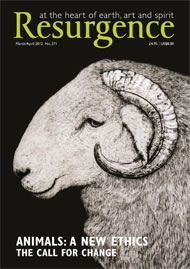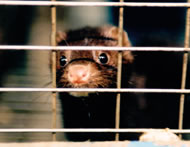An edition of Harper’s Magazine in 1967 carried an advertisement from a company offering 88 different types of fur garments. One item, however, was out of stock: “Unfortunately a Himalayan snow leopard perfect enough to become a Max Bogen fur hasn’t been sighted in over two years. But you can be sure that when the right one comes along, it’ll end up at Max Bogen.”
This cynical announcement typifies the business plan of the fur trade which has, throughout its history, exploited one species after another in the pursuit of profit. It’s an industry that uses every marketing trick in the book and has even tried to paint itself ‘green’ in its attempts to peddle its wares.
The fur industry claims it does not use fur from endangered species. That is it admits to not selling illegal products but fails to address the point that many of these species are endangered exactly because of the trade’s excesses, driven by the whims of fashion.
When Jacqueline Kennedy was seen wearing a leopard-skin coat in 1962 it led to a fashion craze that caused wholesale carnage for spotted cats. In 1968 157,419 spotted cat skins were imported into the USA alone. These included more than 9,000 leopard and 13,000 jaguar skins. The annual slaughter amounted to a one-sided war on the world’s wildlife.
The excessive killing, in part, inspired the creation of the Convention on International Trade in Endangered Species of Wild Fauna and Flora (CITES), which led to the last-minute protection of all the large spotted cat species. But CITES is a trade convention. It allows trade in all but the most threatened of species.
The exploitation of wild animals is but one of the trade’s crimes against Nature. The list of offences includes the release of alien species around the world, chemical pollution, waste of resources, indiscriminate killing of wildlife and, top of the list, widespread and extreme animal cruelty.
More than 70 million animals are killed each year simply for the fur on their backs.
Most of these are now bred in fur factory farms and no one eats the mink and fox carcasses that are their by-product. So these are often simply fed back to the relatives who remain: inmates in tiny wire cages, in which they are forced to live out their miserable lives.
Wild animals trapped for their fur will often chew off their own legs in a frenzied effort to escape. One of the main methods used to catch them is the steel-jawed, leg-hold trap – a device so cruel its use has been banned throughout the European Union.
The UK outlawed this barbaric instrument more than 50 years ago. Darwin wrote about the horror of leg-hold traps in 1863. He said: “It is scarcely possible to exaggerate the suffering thus endured from fear, from acute pain, maddened by thirst, and by vain attempts to escape.”
Almost 150 years later, this same device remains the trap of choice for most fur trappers in North America. And since the traps, once set, do not discriminate their annual toll includes endangered species and even people’s pets. The trappers refer to these hapless creatures as ‘trash’.
Fur factory farming is inherently cruel. Mink and fox, the main species bred for the luxury fur market, are still essentially wild animals. Unlike the more traditional farm species, which have been domesticated over thousands of years, they have been captive-bred for just 100. In addition – and again unlike other farm animals – they are carnivorous predators, and, in the case of mink, solitary. Keeping them in intensive, factory farm conditions leads to distressing conditions such as self-mutilation and even cannibalism.
A year on the fur factory farm follows a regular pattern, with breeding taking place in the spring and killing as soon as these offspring have had their first winter moult – usually at the end beginning of November. At this point their fur is in prime condition and the breeder will want to kill them all before they have had a chance to damage their thick winter coats.
Many thousands of animals are killed in just a few days, often by temporary staff who have no interest whatsoever in the welfare of the animals. Speed of operation is all that matters.
The main methods used to kill are gassing and electrocution. Fox are routinely electrocuted using electrodes clamped in their mouths and inserted in their rectums. Since the current is not applied across the cranium (which would induce unconsciousness), considerable pain is caused and death will result from conditions such as heart attack.
Mink – a semi-aquatic species who have evolved over millions of years to hold their breath under water – are gassed. Typically a killing box towed by a small tractor is driven along the rows of cages. The box contains gas – usually carbon dioxide or carbon monoxide (often piped in from the tractor’s engine) – and mink are shoved in through a trap door, one after another. No film exists of what truly takes place inside that box and their suffering can only be imagined.
But Respect for Animals has filmed the process of removing the animals from their cages and pushing them to their doom. It’s as if they know what’s coming and they fight their handlers for their very lives. Anyone involved in this process wears thick leather gauntlets or their hands would be shredded by the doomed, desperate mink.
Experts on animal slaughter techniques criticise these methods as inappropriate and cruel.
Fur factory farming has evolved not to meet the needs of the animals being kep, but for the breeders’ efficiency and convenience. A mink cage, for instance, is no longer than a person’s arm – nor will it ever be however much the industry promises research and improvements.
In 2001 the European Commission’s Scientific Committee on Animal Health and Animal Welfare (SCAHAW) produced a report the welfare of animals kept for fur production. It said: “Since current husbandry systems cause serious problems for all species of animals reared for fur, efforts should be made for all species to design housing systems which fulfil the needs of the animals.” Ten years later the conditions it criticised and the “serious problems” remain exactly the same.
The fact is the fur industry does not want to change and only government action can bring about what’s necessary – an outright ban. Mink and fox are simply not suited to intensive breeding and fur factory farming is inhumane.
The UK government did examine the issue carefully and concluded: “Fur farming is not consistent with a proper value and respect for animal life.” As a result fur farming in the UK was banned in 2000. Other countries have also taken action with either full or partial bans.
But having banned the two main methods of obtaining fur (the leg-hold trap and fur factory farming) the UK now stands accused of hypocrisy because it still allows the sale of real fur items. In 2010 UK imports of real fur products amounted to some £34.6 million, and part of the fur trade’s marketing strategy in the UK has been to say “fur is back” by pointing to this apparent increase in sales – thereby somehow also trying to say that it’s ‘OK’ to wear fur. But interestingly exports were £41.2 million, making the UK a major international fur trading post.
Most worryingly, fur sales are being inflated by an unknown amount of real fur being sold to people who believe it to be fake.
Market research commissioned by Respect for Animals has shown that most consumers assume that fur on sale on the high street, particularly if it is part of another garment – fur trim – is definitely fake. Since there is no legal requirement to label real fur, confusion reigns. Many people would be horrified to discover that the item they have just bought contains the real fur of a dead animal.
Even retailers have been misled and well-known retailers have had to withdraw lines when it was discovered they were made with real fur.
In the USA this problem does not arise due to new legislation covering any fur on sale. The Truth in Fur Labeling Act makes labelling of real fur a legal requirement. Similar legislation in the UK and the EU is long overdue.
More and more retail outlets are joining Respect for Animals’ Fur Free Retailers programme and, thankfully, no new fur shops are opening.
All this killing, all this misery – for a product nobody needs and for which there are so many compassionate, greener alternatives. We already ban the sale of whale and seal products. It’s time to ban all real fur now.







